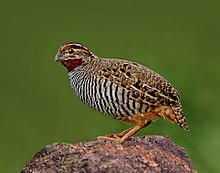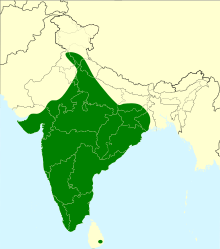| Jungle bush quail | |
|---|---|

| |
| Male | |

| |
| Female | |
| Scientific classification | |
| Domain: | Eukaryota |
| Kingdom: | Animalia |
| Phylum: | Chordata |
| Class: | Aves |
| Order: | Galliformes |
| Family: | Phasianidae |
| Genus: | Perdicula |
| Species: | P. asiatica
|
| Binomial name | |
| Perdicula asiatica (Latham, 1790)
| |

| |
| Synonyms | |
| |
The jungle bush quail (Perdicula asiatica) is a species of quail in the family Phasianidae. It is native to the Indian subcontinent, where it is found in peninsular India and Sri Lanka. It has also been reported from Nepal but has not been seen there since the 19th century, and an introduced population exists on the island of Réunion. A small species of quail 15–18 cm (5.9–7.1 in) long and weighing 57–82 g (2.0–2.9 oz), it shows significant sexual dimorphism. Males have brown upperparts with blackish and buff marking and whitish underparts with black barring. The face is mainly dark reddish-brown, with brown ear-coverts, a buffy-white moustachial stripe, and the supercilium turning whitish towards the back of the neck. Females have a similar pattern, but with pinkish-brown underparts, more uniform wings, and duller moustachial stripes.
The species inhabits dry areas with shrubby or rocky cover in a variety of habitats. It feeds on seeds and small insects, typically in small groups of 6–25 birds. Breeding starts at the end of the rains and lasts until the end of the cold season, with the exact timing varying across its range. It nests in shallow scrapes in cover and lays clutches of 4–8 eggs. Incubation is only done by the female. The International Union for Conservation of Nature considers the jungle bush quail to be of least concern due to its large range and stable population.
- ^ BirdLife International (2018). "Perdicula asiatica". IUCN Red List of Threatened Species. 2018: e.T22678997A131873750. doi:10.2305/IUCN.UK.2018-2.RLTS.T22678997A131873750.en. Retrieved 11 November 2021.
